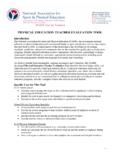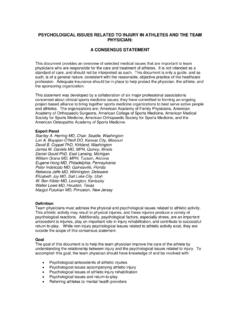Transcription of Years and Curriculum Levels
1 This diagram shows how Curriculum Levels typically relate to Years at school. Many students do not, however, fi t this pattern. They include those with special learning needs, those who are gifted, and those who come from non-English-speaking backgrounds. Students learning an additional language are also unlikely to follow the suggested progression: level 1 is the entry level for those with no prior knowledge of the language being learned, regardless of their school Objectives by LevelThe fold-out charts that follow group achievement objectives by level. This format facilitates cross-curricular collaborative planning and assessment. The achievement objectives are also available in a format that sets them out by Levels within learning areas. In some cases, this second set of charts provides additional and Curriculum LevelsYears and Curriculum LevelsY1Y2Y3Y4Y5Y6Y7Y8Y9Y10Y11Y12Y131188 776655443322206 11 FOLD 410 22 EnglishLevel OneListening, Reading, and ViewingSpeaking, Writing, and PresentingProcesses and strategiesStudents will: Acquire and begin to use sources of information, processes, and strategies to identify, form, and express ideas.
2 INDICATORS: selects and reads texts for enjoyment and personal fulfi lment; has an awareness of the connections between oral, written, and visual language; uses sources of information (meaning, structure, visual and grapho-phonic information) and prior knowledge to make sense of a range of texts; associates sounds with letter clusters as well as with individual letters; uses processing and some comprehension strategies with some confi dence; is developing the ability to think critically about texts; begins to monitor, self-evaluate, and describe using these processes and strategies when listening, reading, or viewing, students will:Purposes and audiences Recognise that texts are shaped for different purposes and audiences. INDICATORS: identifi es the purposes of simple texts; evaluates the usefulness of simple Recognise and identify ideas within and across texts. INDICATORS: understands that personal experience can infl uence the meaning gained from texts; makes meaning of texts by identifying ideas in some features Recognise and begin to understand how language features are used for effect within and across texts.
3 INDICATORS: begins to recognise that oral, written, and visual language features can be used for effect; recognises a large bank of high-frequency and some topic-specifi c words; shows some knowledge of text conventions, such as: capital letters, full stops, and word order; volume and clarity; and simple Recognise and begin to understand text structures. INDICATORS: understands that the order and organisation of words, sentences, and images contribute to text meaning; recognises some text forms and some differences between and strategiesStudents will: Acquire and begin to use sources of information, processes, and strategies to identify, form, and express ideas. INDICATORS: has an awareness of the connections between oral, written, and visual language when creating text; creates texts by using meaning, structure, visual and grapho-phonic sources of information, prior knowledge, and some processing strategies with some confi dence; seeks feedback and makes changes to texts; is becoming refl ective about the production of own texts; begins to monitor, self-evaluate, and describe using these processes and strategies when speaking, writing, or presenting, students will:Purposes and audiences Recognise how to shape texts for a purpose and an audience.
4 INDICATORS: constructs texts that demonstrate some awareness of purpose and audience through appropriate choice of content, language, and text form; expects the texts they create to be understood, responded to, and appreciated by others; is developing and conveying personal voice where Form and express ideas on a range of topics. INDICATORS: forms and expresses simple ideas and information, usually drawing from personal experience and knowledge; begins to support ideas with some features Use language features, showing some recognition of their effects. INDICATORS: uses some oral, written, and visual language features to create meaning and effect; uses a range of high-frequency, topic-specifi c, and personal-content words to create meaning; spells some high-frequency words correctly and begins to use some common spelling patterns; begins to use some strategies to self-correct and monitor spelling; writes most letters and number forms legibly when creating texts; begins to gain control of text conventions, such as: capital letters and full stops; some basic grammatical conventions; volume, clarity, and tone; and simple Organise texts, using simple structures.
5 INDICATORS: uses knowledge of word and sentence order to communicate meaning in simple texts; begins to sequence ideas and information; uses simple sentences with some variation in beginnings; may attempt compound and complex 406 22 The ArtsLevel OneUnderstanding the Arts in ContextDeveloping Practical KnowledgeDeveloping IdeasCommunicating and InterpretingDanceStudents will: Demonstrate an awareness of dance in their lives and in their communities. Explore movement with a developing awareness of the dance elements of body, space, time, energy, and relationships. Improvise and explore movement ideas in response to a variety of stimuli. Share dance movement through informal presentation and share their thoughts and feelings in response to their own and others will: Demonstrate an awareness that drama serves a variety of purposes in their lives and in their communities. Explore the elements of role, focus, action, tension, time, and space through dramatic play.
6 Contribute and develop ideas in drama, using personal experience and imagination. Share drama through informal presentation and respond to ways in which drama tells stories and conveys ideas in their own and others Sound ArtsStudents will: Explore and share ideas about music from a range of sound environments and recognise that music serves a variety of purposes and functions in their lives and in their communities. Explore how sound is made, as they listen and respond to the elements of music: beat, rhythm, pitch, tempo, dynamics, and tone colour. Explore and express sounds and musical ideas, drawing on personal experience, listening, and imagination. Explore ways to represent sound and musical ideas. Share music making with others. Respond to live and recorded ArtsStudents will: Share ideas about how and why their own and others works are made and their purpose, value, and context.
7 Explore a variety of materials and tools and discover elements and selected principles. Investigate visual ideas in response to a variety of motivations, observation, and imagination. Share the ideas, feelings, and stories communicated by their own and others objects and and physical EducationLevel OnePersonal health and physical DevelopmentMovement Concepts and Motor SkillsRelationships with Other PeopleHealthy Communities and EnvironmentsStudents will:Personal growth and development Describe feelings and ask questions about their health , growth, development, and personal needs and physical activity Participate in creative and regular physical activities and identify enjoyable management Describe and use safe practices in a range of contexts and identify people who can identity Describe themselves in relation to a range of will:Movement skills; Science and technology Develop a wide range of movement skills, using a variety of equipment and play attitudes.
8 Challenges and social and cultural factors Participate in a range of games and activities and identify the factors that make participation safe and will:Relationships Explore and share ideas about relationships with other , sensitivity, and respect Demonstrate respect through sharing and co-operation in skills Express their own ideas, needs, wants, and feelings clearly and listen to those of other will:Community resources Identify and discuss obvious hazards in their home, school, and local environment and adopt simple safety , responsibilities, and laws; People and the environment Take individual and collective action to contribute to environments that can be enjoyed by all. Managing self Relating to others Using language, symbols, and texts Participating and contributing ThinkingKey CompetenciesIn a range of meaningful contexts, students will be engaged in thinking mathematically and statistically.
9 They will solve problems and model situations that require them to:Number and AlgebraGeometry and MeasurementStatisticsNumber strategies Use a range of counting, grouping, and equal-sharing strategies with whole numbers and knowledge Know the forward and backward counting sequences of whole numbers to 100. Know groupings with fi ve, within ten, and with and expressions Communicate and explain counting, grouping, and equal-sharing strategies, using words, numbers, and and relationships Generalise that the next counting number gives the result of adding one object to a set and that counting the number of objects in a set tells how many. Create and continue sequential Order and compare objects or events by length, area, volume and capacity, weight (mass), turn (angle), temperature, and time by direct comparison and/or counting whole numbers of Sort objects by their and orientation Give and follow instructions for movement that involve distances, directions, and half or quarter turns.
10 Describe their position relative to a person or Communicate and record the results of translations, refl ections, and rotations on plane investigation Conduct investigations using the statistical enquiry cycle: posing and answering questions; gathering, sorting and counting, and displaying category data; discussing the literacy Interpret statements made by others from statistical investigations and probability Investigate situations that involve elements of chance, acknowledging and anticipating possible a range of meaningful contexts, students will be engaged in thinking mathematically and statistically. They willsolve problems and model situations that require them to:Mathematics and StatisticsLevel OneN&AG&MSLearning LanguagesSee separate chartFOLD 206 32 ScienceLevels One and TwoNature of ScienceStudents will:Understanding about science Appreciate that scientists ask questions about our world that lead to investigations and that open-mindedness is important because there may be more than one in science Extend their experiences and personal explanations of the natural world through exploration, play, asking questions, and discussing simple in science Build their language and develop their understandings of the many ways the natural world can be and contributing Explore and act on issues and questions that link their science learning to their daily WorldStudents will:Planet Earth and BeyondStudents will: physical WorldStudents will:Material WorldStudents will.










